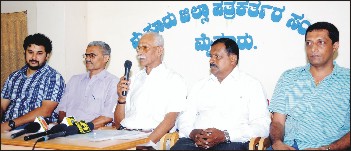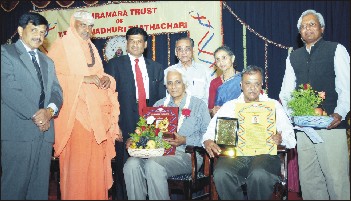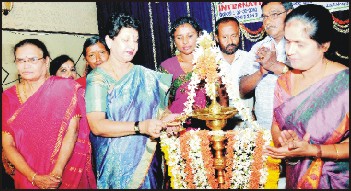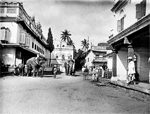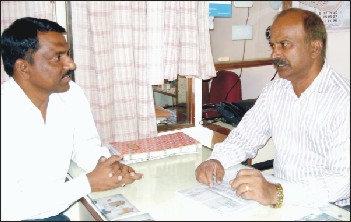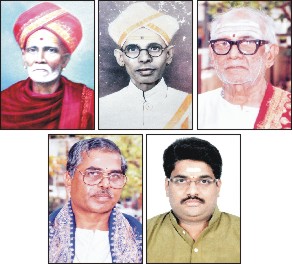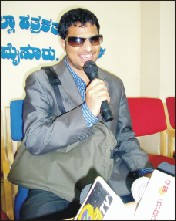On May 30, 1995, Star of Mysore had published a news item titled PUC: City gets 2 ranks in which two students B.S. Manjula of JSS College for Women (9th rank in Arts) and B.S. Suryanarayan (9th rank in Science) were featured.

Now, after 17 years, Manjula, a regular reader of Star of Mysore, has written about her experiences at San Francisco State University from where she obtained an MA in Economics.
Currently residing in Fremont, California, Manjula is working as a Research Analyst at Steele Foundation, San Francisco (home to the famed Golden Gate Bridge).
She is the daughter of late Bhadraswamy, a reader at Government B.Ed. College, KSOU and Amrutha. Here we publish the third in a series of her articles which she sent to SOM, saying ‘My day begins with Star of Mysore!’
Daly City Bart became part of my life throughout San Francisco State University (SFSU) days. The impression it left on my mind is something unique. Even today, whenever I see a Bart train (Bay Area Rapid Transit System) whistling through the wind like a tea kettle, I go down the memory lane, riding Bart, re-calling my long association with it.
Bart is a fast-moving train which stops for a few minutes at every station for passengers to board and get off. It was my only means of transport to the University. I travelled from Fremont to Daly city, one-and-a-half-hours one way, weekly four days. SFSU is located on Daly city border. So from Daly City Bart station to the University, SFSU shuttle which would ply every 15 minutes would take us to the University free-of-cost.
I spent time either “relaxing” or observing people. There were people attired in business suites reading a book or working on their laptop as they travelled to San Francisco. There were students chit chatting with their friends, young mothers with the baby still sleeping in the stroller, beautiful women gently applying make-up and sometimes bubbly school kids visiting some place of interest with their teachers.
Morning 8 to 9 and evening 5 to 7, the train would be full to the brim with tired Indian software engineers, a heavy bag dangling from their shoulders obviously containing a laptop. If there were any baseball matches in the Oakland Coliseum (Stadium), the train would be swarmed with men wearing green T-shirts and green caps, even during 10.30 in the night! There were sometimes beggars begging with decency — “Ma’am could you spare some change please.”
I travelled most of the time off peak hours, closing my eyes, relaxing, unmindful of surroundings and co-passengers. Because of this “relaxing” habit, I landed in many embarrassing situations.
Once it so happened, while returning home I dozed off. I was supposed to get down at Bay Fair station and transfer to the Fremont Bart as there were no direct trains after 7 pm to Fremont from Daly City. When I woke up, I was in Castro station which was way ahead of my destination. I immediately got down from the Bart and boarded the San Francisco train. This time, without fail, I got down at Bay Fair and took a Fremont train home. I reached home at 9.30 pm instead of 8.30 pm. In another such “relaxing moment,” I lost my cell phone worth 200 dollars !
Vending machine Vs long queues
I couldn’t help but compare American transport system with our own Indian transport system. Passengers can buy tickets without any hassle by depositing money in the vending machine or get it from any departmental stores like Safe-way or Rallies. When entering the station, just swipe the ticket at the gate and voila ! you are in.
But Indian railway stations are packed all the time. People should enter the station one hour before they begin their journey only to buy tickets standing in queue getting pushed by all. You are lucky if only pushed by people! Recently, I read that online counters are being introduced in India where you can book your tickets in advance. Thanks to the former Railway Minister Laluji ! I had great expectations from Dinesh Trivedi, a trained pilot, highly educated and widely travelled politician, who was sacked last week for taking a bold step which could have improved the Indian Railways.
During peak hours, like our KSRTC and local trains in Mumbai, Bart was also crowded, but I never saw passengers standing on footsteps of a bus or dangling from the windows. Bart doors once closed could not be opened, unless the driver wished to. Another thing that struck me was punctuality of the system. Trains would arrive and depart exactly at the announced time. The driver would announce the approaching station a few minutes before he entered the station so that the passengers could get ready to disembark the train and there would be no delay in continuing the journey.
Cleanliness is another remarkable feature. There were cleaners wearing hand gloves who came in and cleaned the Bart from time to time at several stops, collecting newspapers and empty plastic cups littered on seats or floor.
Poverty in ‘God’s own land’
Bart train was a home to many homeless and old folks who did not have their own place to live. Often I came across such people who travelled from one end to the other just because they wanted to remain inside the train which was a safe refuge to them from the chilling cold and rain. They slept like a log unaware of the climate while the driver announced our arrival at the Daly City station, the last stop in the line.
Poverty or homelessness was not new to me. It was poverty in America, ‘God’s own land’ that was new to me! Even today several people are under the assumption that US is heaven and there is no poverty in there. People with signboards asking for money, people sitting or sleeping with all their belongings in big plastic bags is not uncommon, especially on the streets of San Francisco. They look like a bundle of rags, no life left in their eyes. The problem has worsened with the collapse of housing market, increasing foreclosures and unemployment in the face of recession. Like any other government, the US government is also trying to help these people in the low rungs of the ladder. How far they have been successful, that is a big question mark with increasing numbers carrying sign-boards on the streets.
Understanding ‘Manku Thimmana Kagga’
I got acquainted with some students who were travelling like me to the University everyday by Bart, who later on became my good friends. One day, I was waiting for the Fremont Bart after I finished my economics class. It was around 6.45 pm. I felt someone pulling my sweater and turned to find a Sardar standing, grinning like a Cheshire cat. He was my classmate Surinder Singh (name changed) who was also enrolled in the same graduate economics class as I were. He was about to graduate the next semester. I had never spoken to him earlier. I would literally run soon after the class to catch my Bart since I was always in a hurry to reach home for I had other responsibilities as a woman.
“Hi,” I greeted him.
“Are you travelling to East Bay?” he asked.
“Yes, to Fremont. You?”
“I stay in Oakland… You come all the way from Fremont! Boy, that’s long commute. I often visit Fremont… I come to the Indian restaurants in Fremont and visit Naz Cinemas to watch Hindi movies,” he replied.
By that time, Fremont train arrived and we hopped on to it. Many times he travelled with me in Bart passionately talking about his ambitions. Surinder was born in India but he migrated to US when he was 9 years old with his parents. He was working for a non-profit organisation in Oakland. Though he spent most of his life in US, he still retained love and respect for India. After his graduation, he wanted go to India and do research in sociology. His eyes gleamed whenever he spoke about his research.
Alas, fate had other plans in store for him. After the semester, I rarely saw him as he finished all required courses. When I heard about him again, he was dead.
It was my last semester in the school. I was sitting in the lab working on my research paper. A Japanese friend of mine came and asked me, “Hey, do you know Surinder?”
“Yes I know him. He was with me in Public econ and Macro class. It has been a long time since I met him. What is the matter?” I questioned.
“He is dead,” he said with a grief-stricken voice.
“What? Surinder is dead? How did he die?” I could not believe he was dead. My friend explained that Surinder was in Hongkong with a group of protesters, protesting against WTO. He returned home safely, but after a week, he died in his apartment alone. He must have caught some infectious disease there which caused his death. My friend even showed me a website in which many of Surinder’s friends had paid their homage.
I was shocked to hear about his death. He was too young to die. He aspired to take up the cause of underprivileged and downtrodden. His death left me with many unanswered questions. Was he in pain when he died? Did he want to see his near and dear ones and talk to them at that moment? Did he want to complete his unfinished tasks before he left this world? What was his fault?
He had vanished like that Cheshire cat in Alice’s Adventures in Wonderland leaving behind only his smile hanging in the air.
“That’s the way of life. Everyone has to go one day. Birth and death, pain and pleasure, childhood and old age — no one can ever escape from this cycle,” my husband said when I narrated the incident to him.
“Yes I know, it is inevitable. But it is so hard to accept that he is no more,” I said.
“Yes, I know, it is hard to believe. Accept it or not, that is the eternal truth and we must live with it,” he declared.
There was this song from Manku Thimmana Kagga playing on our music stereo in the car—”Baduku jataka bandi, Vidhi adara saheba; Kudure neen, Avanu peldante payanigaru; Maduvego masanako hogenda kadegodu; Pada kusiye nelavihudu mankuthimma.”
[Meaning: Life is a horse driven cart, fate its driver,
You’re the horse, passengers in it decided by God,
Go wherever fate decides, either to burial ground or marriage hall,
When stumbled, God will support you.]
source: http://www.StarofMysore.com / Features/ Tuesday, March 27th, 2012
